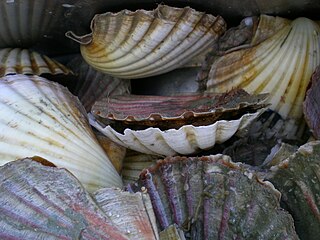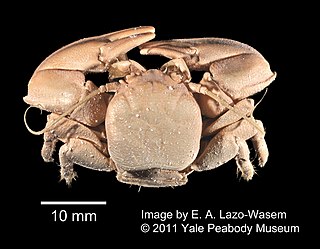
The New Zealand pea crab, is a species of small, parasitic crab that lives most commonly inside New Zealand green-lipped mussels. Adult females are about the size and shape of a pea, while adult males are smaller and flatter. Adult New Zealand pea crabs are completely reliant on their host mussel for shelter and food, which it steals from the mussel's gills. The New Zealand pea crab is found throughout New Zealand and can infect up to 70% of natural populations. These crabs are of concern to green-lipped mussel aquaculture because they reduce the size and growth of mussels, although infected mussels can be harvested and consumed.

Porcelain crabs are decapod crustaceans in the widespread family Porcellanidae, which superficially resemble true crabs. They have flattened bodies as an adaptation for living in rock crevices. They are delicate, readily losing limbs when attacked, and use their large claws for maintaining territories. They first appeared in the Tithonian age of the Late Jurassic epoch, 145–152 million years ago.

Perna canaliculus, the New Zealand green-lipped mussel, also known as the New Zealand mussel, the greenshell mussel, kuku, and kutai, is a bivalve mollusc in the family Mytilidae. P. canaliculus has economic importance as a cultivated species in New Zealand.
The blue grenadier is a merluccid hake of the family Merlucciidae found around southern Australia and New Zealand, as well as off both the Atlantic and Pacific coasts of South America from Peru to Brazil at depths of between 10 and 1,000 m. It feeds in midwater on small squids, crustaceans, and fish. Its length is between 60 and 120 cm. It is a slender, silvery fish similar in appearance to the gemfish. The meat of the fish is white and almost always sold in fillets; culinarily it is considered a whitefish.

The red-crowned parakeet, also known as red-fronted parakeet and by its Māori name of kākāriki, is a small parrot from New Zealand. It is characterised by its bright green plumage and the red pattern on its head. This versatile bird can feed on a variety food items and can be found in many habitat types. It used to be classified as near threatened as invasive predators had pushed it out of its historical range but it is now at least concern. This species used to occupy the entire island, but is now confined to only a few areas on the mainland and some offshore islands.

Hemigrapsus sexdentatus, also called the “common rock crab” or “common shore crab,” is a marine crab indigenous to the southern shores of New Zealand. This crab is a member of the Varunidae family in the order Decapoda.

The Smooth Shore Crab is a marine large-eyed crab of the family Grapsidae, found in New Zealand and the Juan Fernández Islands of Chile.

The pea crab, Pinnotheres pisum, is a small crab in the family Pinnotheridae that lives as a parasite in oysters, clams, mussels, and other species of bivalves.

The pie crust crab, is a species of crab found around New Zealand and south-eastern Australia.

Petrolisthes elongatus, known as the New Zealand half crab, elongated porcelain crab, blue half crab, blue false crab or simply as the half crab or false crab, is a species of porcelain crab native to New Zealand.

The New Zealand quail, or koreke in Māori, is an extinct quail species endemic to New Zealand. The male and female were similar, except the female was lighter. The first scientist to describe it was Sir Joseph Banks when he visited New Zealand on James Cook's first voyage. Terrestrial and temperate, this species inhabited lowland tussock grassland and open fernlands. The first specimen to be obtained by a European was collected in 1827 by Jean René Constant Quoy and Joseph Paul Gaimard on Dumont D'Urville's voyage. It most likely went extinct due to diseases from introduced game birds.

Notomithrax ursus, known as the hairy seaweed crab, is a spider crab of the family Majidae.

Pagurus novizealandiae, or the New Zealand hermit crab is a hermit crab of the family Paguridae, endemic to New Zealand. Its body is up to 16 millimetres (0.63 in) wide.

Sigapatella novaezelandiae, common name the circular slipper limpet, is a species of medium-sized sea snail, a marine gastropod molluscs in the family Calyptraeidae.

The New Zealand bittern is an extinct and enigmatic species of heron in the family Ardeidae. It was endemic to New Zealand and was last recorded alive in the 1890s.

Pecten novaezelandiae, common name the New Zealand scallop, is a bivalve mollusc of the family Pectinidae, the scallops. Its name is sometimes found misspelt as Pecten novaezealandiae.

Petrolisthes eriomerus is a species of marine porcelain crab found in the eastern Pacific Ocean. It is commonly known as the flattop crab. It is a flattened, rounded animal, with a carapace up to 20 mm (0.8 in) across. It is a filter feeder, and also sweeps food from rocks.

Petrolisthes armatus, the green porcelain crab, is a species of small porcelain crab in the family Porcellanidae. It is believed to be native to Brazil but has spread to other parts of the world. Populations in the south eastern part of the United States have increased dramatically and the species is considered to be an invasive species.

















